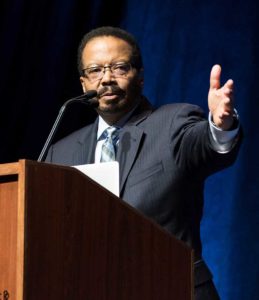Roderic Pettigrew, Innovator in Biomedicine and Technology, Is the 2020 Winner of the Vannevar Bush Award

 BRYAN-COLLEGE STATION, Texas — Gov. Greg Abbott on Monday congratulated the head of Texas A&M University’s Engineering Medicine, or EnMed, program, who will receive a prestigious lifetime achievement award from the National Science Board.
BRYAN-COLLEGE STATION, Texas — Gov. Greg Abbott on Monday congratulated the head of Texas A&M University’s Engineering Medicine, or EnMed, program, who will receive a prestigious lifetime achievement award from the National Science Board.
The board announced Monday Roderic Pettigrew will be presented with the Vannevar Bush Award, which is considered one of the nation’s highest science awards. It honors lifelong science and technology leaders who have made exceptional contributions to the welfare of the nation through public service in science and technology and in shaping public policy.
“Roderic Pettigrew’s passion and creativity have spurred innovation in biomedicine,” said Victor McCrary, Vice Chair of the National Science Board and Chair of the 2020 NSB Honorary Awards Subcommittee. “His reimagining of healthcare solutions is helping converge science fields, narrowing gaps between disciplines in a way that really impacts society. Pettigrew is helping us to see what might be, what could be, and what is possible.”
Pettigrew’s contributions are wide-ranging. They include:
- His service as the founding director of the National Institute of Biomedical Imaging and Bioengineering (NIBIB) at the National Institutes of Health.
- His advanced treatment for spinal injuries that enabled some chronically paralyzed men to regain voluntary muscle movement and sensory function.
- His use of radiation in cancer treatments.
- His work to use MRI to image the beating heart and quantify blood flow.
- His establishment of a partnership with the Indian government to develop cuff-less blood pressure measurement, along with other low cost diagnostic and therapeutic technologies.
Pettigrew’s work also involved bringing out the best in others. While at NIH created the Quantum Grants Program to encourage researchers to undertake “medical moon shots” to solve major challenges through technological innovation.
Pettigrew continues to help others archive greatness at Texas A&M, where he leads EnMed in Houston. The program blends engineering and medicine in a 4-year curriculum to develop problem-solving “physicianeers;” graduates who earn a medical degree and a master’s degree in engineering. Plus, they must invent a solution to a healthcare problem that is ready for a patent.
“It is an incredible honor to receive the Vannevar Bush Award, which is so steeped in science history,” Pettigrew said. “My only regret is that my parents are not alive to share this honor. They were my first role models.”
Pettigrew was raised in rural Georgia and attended segregated public schools before attending Morehouse College in Atlanta through a Merrill Scholarship. After graduating with a B.S. in physics in 1972, he earned a M.S. in nuclear science and engineering at Rensselaer Polytechnic Institute and a Ph.D. in Applied Radiation Physics at Massachusetts Institute of Technology, where his work resulted in a new type of neutron activation radiation treatment of malignant brain tumors being pioneered at MIT-Harvard. In 1979 he received an M.D. from the University of Miami.
In recent years, he has been elected to the National Academy of Medicine, the National Academy of Engineering, the American Academy of Arts and Sciences and the National Academy of Sciences India. He has received the Pierre Galletti Award from the American Institute for Medical and Biological Engineering, the Distinguished Service Award of both the International Society of Magnetic Resonance in Medicine and National Medical Association, the Pritzker Achievement Award of the Biomedical Engineering Society, and was the first winner of the Gold Medal of the Academy of Radiology Research. He also was awarded a Gold Medal from the Radiological Society of North America and received the Arthur M. Bueche Award from the National Academy of Engineering.
The NSB created the award in 1980 in memory of Vannevar Bush, who served as a science advisor to President Franklin Roosevelt during World War II, helped to establish federal funding for science and engineering as a national priority during peacetime and was behind the creation of the National Science Foundation. Past award recipients include: Leon Lederman (Fermilab), Nobel Laureate Harold Varmus (former NIH Director), Nobel Laureate Charles Townes (UC Berkeley -Laser Inventor), David Packard (Hewlett-Packard Company), Rita Colwell (former NSF Director), Charles Vest (former MIT President), and last year, Walter Massey (University of Chicago – oversaw Giant Magellan Telescope).
About the National Science Board
The National Science Board and the National Science Foundation’s Director jointly head NSF. NSB identifies issues critical to NSF’s future and establishes the agency’s policies. The NSB also provides the President and Congress with Science and Engineering Indicators, a biennial report on the state of science and engineering in the United States. Members are appointed by the President for six-year terms and selected for their eminence in research, education and records of distinguished service.
About The Texas A&M University System
The Texas A&M University System is one of the largest systems of higher education in the nation with a budget of $6.3 billion. The System is a statewide network of 11 universities; a comprehensive health science center; eight state agencies, including the Texas Division of Emergency Management; and the RELLIS Campus. The Texas A&M System educates more than 151,000 students and makes more than 22 million additional educational contacts through service and outreach programs each year. System-wide, research and development expenditures exceeded $1 billion in FY 2019 and helped drive the state’s economy.
Contact: Laylan Copelin
Vice Chancellor of Marketing and Communications
(979) 458-6425
(512) 289-2782 cell
lcopelin@tamus.edu